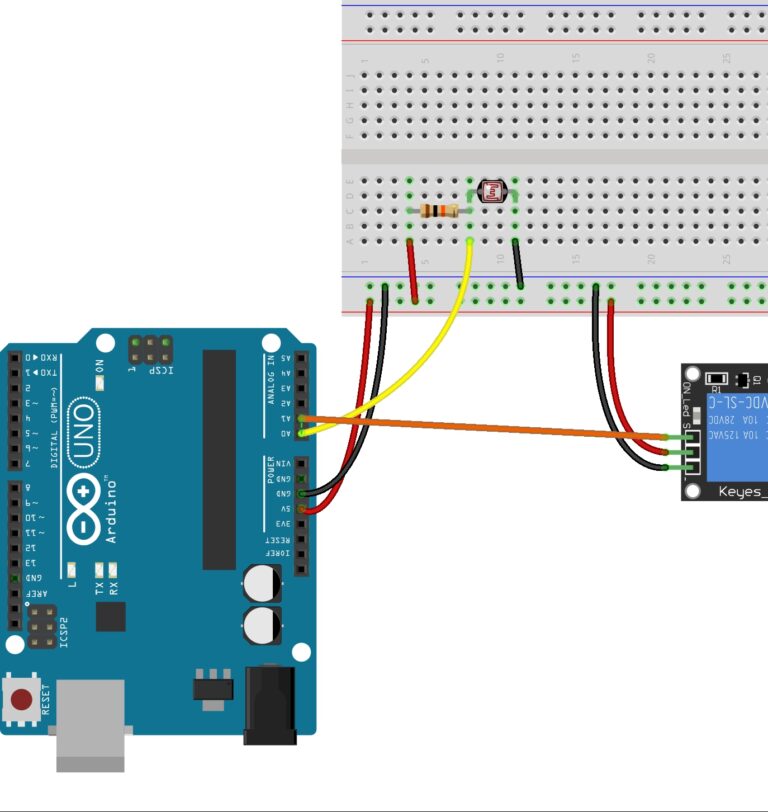www.huvitera.ee/arduino-27M

Valgussensor joonise järgi.
Releed ei ole vaja ühendada.
Lisa 4 LEDi:
Roheline nr 5
Punane nr 4
Sinine nr 3
Kollane nr 2
// DEFINES
// Flag to toggle debugging output
#define DEBUG
// CONSTANTS
// The input pin the LDR is connected to. Must be an analogue pin
// (i.e. pins A0-A5 on an Arduino UNO). Somewhat confusingly, the pins on a digispark
// are addressed differently as analog pins than as digital pins, so A2 is the same as D4.
const byte ldrPin = A0;
// This digital pin will be driven LOW to release a lock when puzzle is solved
// Can be any pin capable of digital output
const byte lockPin = A1;
// GLOBALS
// The "base reading" is the resistance of the LDR measured
// in normal lighting of the room, and will be calibrated
// each time the puzzle is reset
int baseReading = 512;
// currentReading is the resistance of the LDR, which
// changes when a light is shone at it (resistance falls)
// or light blocked from it (resistance rises)
int currentReading;
// The LDR reading will naturally fluctuate slightly. This
// sensitivity value will be used as a threshold to determine when
// it has changed enough for the puzzle to be considered to have
// been solved.
const int sensitivity = 30;
int ledPinK = 2;
int ledPinS = 3;
int ledPinP = 4;
int ledPinR = 5;
// Track state of overall puzzle
enum PuzzleState {Initialising, Running, Solved};
PuzzleState puzzleState = Initialising;
/**
* Returns true if the puzzle has been solved, false otherwise
*/
bool checkIfPuzzleSolved(){
return (currentReading > baseReading + sensitivity);
}
/**
* Called when the puzzle is solved
*/
void onSolve() {
#ifdef DEBUG
Serial.println("Puzzle has just been solved!");
#endif
// Release the lock
digitalWrite(lockPin, LOW);
digitalWrite(ledPinR, HIGH); // set the LED on.
digitalWrite(ledPinP, HIGH);
digitalWrite(ledPinS, HIGH);
digitalWrite(ledPinK, HIGH);
delay(500);
digitalWrite(ledPinR, LOW); // set the LED on.
digitalWrite(ledPinP, LOW);
digitalWrite(ledPinS, LOW);
digitalWrite(ledPinK, LOW);
delay(500);
digitalWrite(ledPinR, HIGH); // set the LED on.
digitalWrite(ledPinP, HIGH);
digitalWrite(ledPinS, HIGH);
digitalWrite(ledPinK, HIGH);
delay(500);
digitalWrite(ledPinR, LOW); // set the LED on.
digitalWrite(ledPinP, LOW);
digitalWrite(ledPinS, LOW);
digitalWrite(ledPinK, LOW);
delay(500);
digitalWrite(ledPinR, HIGH); // set the LED on.
digitalWrite(ledPinP, HIGH);
digitalWrite(ledPinK, HIGH);
delay(500);
digitalWrite(ledPinR, LOW); // set the LED on.
digitalWrite(ledPinP, LOW);
digitalWrite(ledPinS, LOW);
digitalWrite(ledPinK, LOW);
delay(500);
digitalWrite(ledPinR, HIGH); // set the LED on.
digitalWrite(ledPinP, HIGH);
digitalWrite(ledPinK, HIGH);
delay(500);
digitalWrite(ledPinR, LOW); // set the LED on.
digitalWrite(ledPinP, LOW);
digitalWrite(ledPinS, LOW);
digitalWrite(ledPinK, LOW);
delay(500);
digitalWrite(ledPinR, HIGH); // set the LED on.
digitalWrite(ledPinP, HIGH);
delay(500);
digitalWrite(ledPinR, LOW); // set the LED on.
digitalWrite(ledPinP, LOW);
digitalWrite(ledPinS, LOW);
digitalWrite(ledPinK, LOW);
delay(500);
digitalWrite(ledPinR, HIGH); // set the LED on.
digitalWrite(ledPinP, HIGH);
delay(500);
digitalWrite(ledPinR, LOW); // set the LED on.
digitalWrite(ledPinP, LOW);
digitalWrite(ledPinS, LOW);
digitalWrite(ledPinK, LOW);
delay(500);
digitalWrite(ledPinR, HIGH); // set the LED on.
delay(500);
digitalWrite(ledPinR, LOW); // set the LED on.
digitalWrite(ledPinP, LOW);
digitalWrite(ledPinS, LOW);
digitalWrite(ledPinK, LOW);
delay(500);
digitalWrite(ledPinR, HIGH); // set the LED on.
delay(500);
digitalWrite(ledPinR, LOW); // set the LED on.
digitalWrite(ledPinP, LOW);
digitalWrite(ledPinS, LOW);
digitalWrite(ledPinK, LOW);
delay(500);
puzzleState = Solved;
}
/**
* Called when the puzzle (which previously had been solved) becomes unsolved
*/
void onUnsolve() {
#ifdef DEBUG
Serial.println("Puzzle has just become unsolved!");
#endif
// Lock the lock again
digitalWrite(lockPin, HIGH);
puzzleState = Running;
}
/**
* Initialisation
*/
void setup(){
pinMode(ledPinS, OUTPUT);
pinMode(ledPinP, OUTPUT);
pinMode(ledPinK, OUTPUT);
pinMode(ledPinR, OUTPUT);
#ifdef DEBUG
// Initialise serial communications channel with the PC
Serial.begin(9600);
#endif
// Set the LDR pin as input
pinMode(ldrPin, INPUT);
// Set the lock pin as output and secure the lock
pinMode(lockPin, OUTPUT);
digitalWrite(lockPin, HIGH);
}
/**
* Main program loop runs indefinitely
*/
void loop(){
// Take the current measurement from the sensor
// When the sensor is covered, this value rises. When it receives more light, it falls.
currentReading = analogRead(ldrPin);
// Log the output to the serial connection if debugging enabled
#ifdef DEBUG
Serial.println(currentReading);
delay(250); // Slow down the output
#endif
// Switch action based on the current state of the puzzle
switch(puzzleState) {
case Initialising:
calibrate();
puzzleState = Running;
break;
case Running:
if(checkIfPuzzleSolved()){
onSolve();
}
break;
case Solved:
if (!checkIfPuzzleSolved()){
onUnsolve();
}
break;
}
}
/**
* Calibrates the base reading of the sensor
*/
void calibrate(){
// Calculate a mean average reading over 10 samples
int numSamples = 10;
int total = 0;
for(int i=0; i<numSamples; i++) {
delay(100);
total += analogRead(ldrPin);
}
baseReading = total / numSamples;
// Print debug information to the serial connection
#ifdef DEBUG
Serial.print("Sensor initialised at base level: ");
Serial.println(baseReading);
Serial.println("---");
#endif
}

NR2 – Potentsiomeeter ja LED ribad
/**
* "Valves" Puzzle
*
* To solve this puzzle, players must adjust a series of "valves" (potentiometers) to adjust the level
* of a set of corresponding pipes, as indicated by LED strips.
* When all pipes have been set to the correct level, the puzzle is solved and a relay is triggered, which
* can release a maglock, activate a siren, light a lamp etc. etc.
*
* Demonstrates:
* - LED Strips
* - Potentiometers
*
* Updated 20190915 : Changed pin numbers from 3/4/5 to 10/9/8 to reflect wiring used in video
*/
// INCLUDES
// Library for controlling LED strips, available from https://github.com/FastLED/FastLED
#include "FastLED.h"
// DEFINES
// Flag to toggle debugging output
// #define DEBUG
// There are only *9* LEDs in each strip representing the numbers 1-9.
// No need for 10 LEDs, because for the digit 0 all the LEDs are simply turned off!
#define numLEDsInEachStrip 9
// CONSTANTS
// The input pins to which the potentiometers is connected. NOTE - Must use analog (Ax) input pins!
const byte potPins[] = {A0, A1, A2};
// The total number of valves
const byte numPots = 3;
// The level to which each valve must be set to solve the puzzle
const int solution[numPots] = {5, 2, 9};
// This digital pin will be driven LOW to release a lock when puzzle is solved
const byte lockPin = A5;
// NOTE: the pins to which the LED strips are connected is hardcoded in setup, not here.
// GLOBALS
// This array will record the current reading of each input valve
int currentReadings[numPots] = {};
// An multidimensional LED array - one element for each LED, arranged into separate arrays for each potentiometer
CRGB leds[numPots][numLEDsInEachStrip];
// To make the LED colours more interesting, we'll add some random noise offset
static uint16_t noiseOffset[3];
// This is the array that we keep our computed noise values in
uint8_t noise[numPots][numLEDsInEachStrip];
// Track state of overall puzzle
enum PuzzleState {Initialising, Running, Solved};
PuzzleState puzzleState = Initialising;
/**
* Returns true if the puzzle has been solved, false otherwise
*/
bool checkIfPuzzleSolved(){
for(int i=0; i<numPots; i++) {
if(currentReadings[i] != solution[i]) {
return false;
}
}
return true;
}
/**
* Called when the puzzle is solved
*/
void onSolve() {
#ifdef DEBUG
Serial.println("Puzzle has just been solved!");
#endif
// Release the lock
digitalWrite(lockPin, LOW);
puzzleState = Solved;
}
/**
* Called when the puzzle (which previously had been solved) becomes unsolved
*/
void onUnsolve() {
#ifdef DEBUG
Serial.println("Puzzle has just become unsolved!");
#endif
// Lock the lock again
digitalWrite(lockPin, HIGH);
puzzleState = Running;
}
/**
* Initialisation
*/
void setup(){
#ifdef DEBUG
// Initialise serial communications channel with the PC
Serial.begin(9600);
#endif
// Set the linear pot pins as input
for(int i=0; i<numPots; i++){
// Set the pin for the pot
pinMode(potPins[i], INPUT);
}
// Create and assign the arrays of LEDs on the pins corresponding to each pot
// NOTE: The template initialisation function used by the FastLED library requires pin numbers to be constants defined at compile-time.
// Therefore we can't loop over an array of pin numbers as we do with the pots, and instead manually call addLeds() several times with hardcoded pin values
FastLED.addLeds<NEOPIXEL, 10>(leds[0], numLEDsInEachStrip);
FastLED.addLeds<NEOPIXEL, 9>(leds[1], numLEDsInEachStrip);
FastLED.addLeds<NEOPIXEL, 8>(leds[2], numLEDsInEachStrip);
// Set the lock pin as output and secure the lock
pinMode(lockPin, OUTPUT);
digitalWrite(lockPin, HIGH);
// Initialise some random noise values to add variety to the LED colours
noiseOffset[0] = random16();
noiseOffset[1] = random16();
noiseOffset[2] = random16();
// Set the puzzle into the running state
puzzleState = Running;
}
// Create an array of "noise" - one value for each LED
void fillnoise8(uint16_t speed, uint16_t scale) {
for(int i = 0; i < numPots; i++) {
for(int j = 0; j < numLEDsInEachStrip; j++) {
noise[i][j] = inoise8(noiseOffset[0] + (i*scale), noiseOffset[1] + (j*scale), noiseOffset[2]);
}
}
noiseOffset[2] += speed;
}
// The Arduino map() function produces incorrect distribution for integers. See https://github.com/arduino/Arduino/issues/2466
// So, create a fixed function instead:
long map2(long x, long in_min, long in_max, long out_min, long out_max) {
return (x - in_min) * (out_max - out_min+1) / (in_max - in_min+1) + out_min;
}
/**
* Read the input from the potentiometers and store in the currentReadings array
*/
void getInput() {
// Read the value from the pots
for(int i=0; i<numPots; i++){
// Get the "raw" input, which is a value from 0-1023
int rawValue = analogRead(potPins[i]);
// Scale the value to the number of LEDs in each strip
int scaledValue = map2(rawValue, 0, 1023, 0, numLEDsInEachStrip);
// To ensure we don't get any dodgy values, constrain the output range too
scaledValue = constrain(scaledValue, 0, numLEDsInEachStrip);
// Store the scaled value in the currentReadings array
currentReadings[i] = scaledValue;
// Print some debug information
#ifdef DEBUG
Serial.print("Valve ");
Serial.print(i);
Serial.print(" raw:");
Serial.print(rawValue);
Serial.print(", scaled:");
Serial.println(scaledValue);
delay(50);
#endif
}
}
/**
* Set the LEDs in the chosen style
*/
void setDisplay(int style = 0) {
// Fill the noise array with values
// The first parameter determines the speed and the second the scale of the generated noise. Try playing with them!
fillnoise8(5, 255);
// Clear the LEDs
FastLED.clear();
// Loop over each input
for(int i=0; i<numPots; i++){
// Now count up from 0 to the reading for this LED
for(int x=0; x<currentReadings[i]; x++){
// Colour the LEDs according to the chosen style
switch(style){
case 0:
// Noisy (i.e. random) colours
leds[i][x] = CHSV(noise[i][x], 255, 160);
break;
case 1:
// Blue hue but with some variation in hue and brightness
leds[i][x] = CHSV(
150 + (int)(noise[i][x]>>2),
255,
constrain(16 + (2<<x) + (int)(noise[i][x]>>1), 0, 255)
);
break;
default:
// Block solid colour
leds[i][x] = CRGB::Blue;
break;
}
}
// Colour the top LED of each line
if(currentReadings[i] > 0) {
leds[i][currentReadings[i]-1] = CRGB(255,255,255);
}
}
// Having assigned the colour, show the LEDs
FastLED.show();
}
/**
* Main program loop runs indefinitely
*/
void loop(){
// Switch action based on the current state of the puzzle
switch(puzzleState) {
case Initialising:
puzzleState = Running;
break;
case Running:
getInput();
setDisplay(1);
if(checkIfPuzzleSolved()){
onSolve();
}
break;
case Solved:
setDisplay(0);
/*
getInput();
setDisplay(0);
if (!checkIfPuzzleSolved()){
onUnsolve();
}
*/
break;
}
}

